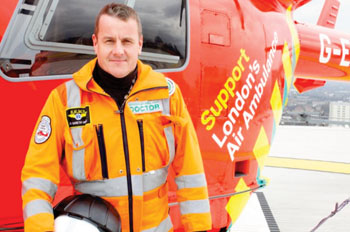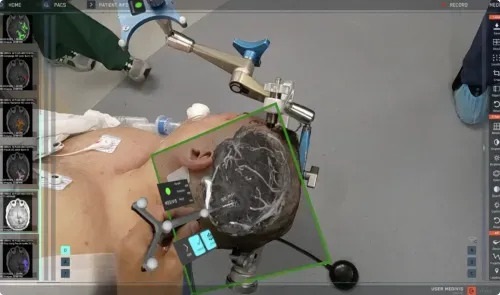LAA Performs Pioneering Roadside Occlusive Balloon Surgery
|
By HospiMedica International staff writers Posted on 30 Jun 2014 |

Image: Dr. Gareth Davies, medical director of the LAA (Photo courtesy of London Air Ambulance).
The London Air Ambulance (LAA; United Kingdom) has performed the world’s first roadside resuscitative endovascular balloon occlusion of the aorta (REBOA) to control internal bleeding.
REBOA is a proactive circulatory support method for hypotensive patients at risk of cardiovascular collapse. It works by controlling or preventing further blood loss via a balloon fed into the inferior part of the aorta and then inflated, temporarily cutting off blood supply to damaged blood vessels. Occlusion of the thoracic aorta can provide inflow control in patients with exsanguinating abdominal trauma, whereas occlusion of the infrarenal aorta can control pelvic hemorrhage.
The pioneering technique could prevent trauma patients bleeding to death from severe pelvic hemorrhage, an injury most commonly associated with cycling incidents and falls from height. The technique was developed over two year in conjunction with the Royal London Hospital (RLH; United Kingdom), the LAA’s home base, which continues treatment of the patient with further hospital interventions.
“We believe the use of REBOA can lead to a reduction in the number of patients who quite simply bleed to death before they have the chance to get to hospital where there are highly developed systems for stabilizing and preventing blood loss,” said Gareth Davies, MD, medical director of the LAA. “Our aim is to provide our patients with the world’s most innovative and effective pre-hospital care. Being able to effectively manage blood loss at the scene is a significant advancement in pre-hospital medicine.”
“We have to stop people bleeding to death—it's one of the world's biggest killers. Over 2.5 million people bleed to death from their injuries each year around the world,” added Prof. Karim Brohi, consultant vascular and trauma surgeon at RLH. “While it sounds relatively simple it is an extremely difficult technology to deliver in the emergency department in hospital, never mind at the roadside. We are excited about the potential for REBOA to reduce death and suffering after trauma and will continue to evaluate and develop the technology into the future.”
LAA is a registered charity that functions as a mobile emergency department in life-threatening, time-critical situations, and carries a senior doctor (in addition to a paramedic) at all times on a helicopter, thus reducing the death rate in severe trauma by 30%–40%. Based in RLH, the helicopter can reach any patient inside the M25 London orbital road within 15 minutes. Missions commonly involve serious road traffic collisions, falls from height, stabbings and shootings, industrial accidents, and incidents on the rail network. The team can provide advanced life-saving medical interventions, including open heart surgery, blood transfusion, and anesthesia at the scene.
Related Links:
London Air Ambulance
Royal London Hospital
REBOA is a proactive circulatory support method for hypotensive patients at risk of cardiovascular collapse. It works by controlling or preventing further blood loss via a balloon fed into the inferior part of the aorta and then inflated, temporarily cutting off blood supply to damaged blood vessels. Occlusion of the thoracic aorta can provide inflow control in patients with exsanguinating abdominal trauma, whereas occlusion of the infrarenal aorta can control pelvic hemorrhage.
The pioneering technique could prevent trauma patients bleeding to death from severe pelvic hemorrhage, an injury most commonly associated with cycling incidents and falls from height. The technique was developed over two year in conjunction with the Royal London Hospital (RLH; United Kingdom), the LAA’s home base, which continues treatment of the patient with further hospital interventions.
“We believe the use of REBOA can lead to a reduction in the number of patients who quite simply bleed to death before they have the chance to get to hospital where there are highly developed systems for stabilizing and preventing blood loss,” said Gareth Davies, MD, medical director of the LAA. “Our aim is to provide our patients with the world’s most innovative and effective pre-hospital care. Being able to effectively manage blood loss at the scene is a significant advancement in pre-hospital medicine.”
“We have to stop people bleeding to death—it's one of the world's biggest killers. Over 2.5 million people bleed to death from their injuries each year around the world,” added Prof. Karim Brohi, consultant vascular and trauma surgeon at RLH. “While it sounds relatively simple it is an extremely difficult technology to deliver in the emergency department in hospital, never mind at the roadside. We are excited about the potential for REBOA to reduce death and suffering after trauma and will continue to evaluate and develop the technology into the future.”
LAA is a registered charity that functions as a mobile emergency department in life-threatening, time-critical situations, and carries a senior doctor (in addition to a paramedic) at all times on a helicopter, thus reducing the death rate in severe trauma by 30%–40%. Based in RLH, the helicopter can reach any patient inside the M25 London orbital road within 15 minutes. Missions commonly involve serious road traffic collisions, falls from height, stabbings and shootings, industrial accidents, and incidents on the rail network. The team can provide advanced life-saving medical interventions, including open heart surgery, blood transfusion, and anesthesia at the scene.
Related Links:
London Air Ambulance
Royal London Hospital
Latest Critical Care News
- Transcatheter Valve Replacement Outcomes Similar To Surgery, Finds Study
- Revascularization Improves Life Quality in Chronic Limb-Threatening Ischemia, Finds Study
- Powerful AI Risk Assessment Tool Predicts Outcomes in Heart Failure Patients
- Peptide-Based Hydrogels Repair Damaged Organs and Tissues On-The-Spot
- One-Hour Endoscopic Procedure Could Eliminate Need for Insulin for Type 2 Diabetes
- AI Can Prioritize Emergency Department Patients Requiring Urgent Treatment
- AI to Improve Diagnosis of Atrial Fibrillation
- Stretchable Microneedles to Help In Accurate Tracking of Abnormalities and Identifying Rapid Treatment
- Machine Learning Tool Identifies Rare, Undiagnosed Immune Disorders from Patient EHRs
- On-Skin Wearable Bioelectronic Device Paves Way for Intelligent Implants
- First-Of-Its-Kind Dissolvable Stent to Improve Outcomes for Patients with Severe PAD
- AI Brain-Age Estimation Technology Uses EEG Scans to Screen for Degenerative Diseases
- Wheeze-Counting Wearable Device Monitors Patient's Breathing In Real Time
- Wearable Multiplex Biosensors Could Revolutionize COPD Management
- New Low-Energy Defibrillation Method Controls Cardiac Arrhythmias
- New Machine Learning Models Help Predict Heart Disease Risk in Women
Channels
Artificial Intelligence
view channel
AI-Powered Algorithm to Revolutionize Detection of Atrial Fibrillation
Atrial fibrillation (AFib), a condition characterized by an irregular and often rapid heart rate, is linked to increased risks of stroke and heart failure. This is because the irregular heartbeat in AFib... Read more
AI Diagnostic Tool Accurately Detects Valvular Disorders Often Missed by Doctors
Doctors generally use stethoscopes to listen for the characteristic lub-dub sounds made by heart valves opening and closing. They also listen for less prominent sounds that indicate problems with these valves.... Read moreCritical Care
view channel.jpeg)
Transcatheter Valve Replacement Outcomes Similar To Surgery, Finds Study
A new study has shown that a minimally invasive procedure for replacing the aortic valve in the heart—known as transcatheter aortic valve replacement (TAVR)—is on par with the more traditional surgical... Read more
Revascularization Improves Life Quality in Chronic Limb-Threatening Ischemia, Finds Study
Researchers have undertaken a detailed study to evaluate the effects of revascularization strategies on the health-related quality of life (HRQoL) of patients with chronic limb-threatening ischemia.... Read moreSurgical Techniques
view channel
AR Surgical Technology Translates Complex 2D Medical Imaging to Enhance Accuracy
Surgeons often have to switch their focus between a patient’s data displayed on a screen or clipboard and the patient themselves during procedures. But that is about to change. Surgeons can now utilize... Read more
Miniaturized Snake-Like Probe Images Cerebral Arteries From Within
Endovascular interventions are being increasingly favored for treating strokes and cerebral artery diseases, but rely heavily on angiographical imaging that often struggles with limited contrast and spatial... Read morePatient Care
view channelFirst-Of-Its-Kind Portable Germicidal Light Technology Disinfects High-Touch Clinical Surfaces in Seconds
Reducing healthcare-acquired infections (HAIs) remains a pressing issue within global healthcare systems. In the United States alone, 1.7 million patients contract HAIs annually, leading to approximately... Read more
Surgical Capacity Optimization Solution Helps Hospitals Boost OR Utilization
An innovative solution has the capability to transform surgical capacity utilization by targeting the root cause of surgical block time inefficiencies. Fujitsu Limited’s (Tokyo, Japan) Surgical Capacity... Read more
Game-Changing Innovation in Surgical Instrument Sterilization Significantly Improves OR Throughput
A groundbreaking innovation enables hospitals to significantly improve instrument processing time and throughput in operating rooms (ORs) and sterile processing departments. Turbett Surgical, Inc.... Read moreHealth IT
view channel
Machine Learning Model Improves Mortality Risk Prediction for Cardiac Surgery Patients
Machine learning algorithms have been deployed to create predictive models in various medical fields, with some demonstrating improved outcomes compared to their standard-of-care counterparts.... Read more
Strategic Collaboration to Develop and Integrate Generative AI into Healthcare
Top industry experts have underscored the immediate requirement for healthcare systems and hospitals to respond to severe cost and margin pressures. Close to half of U.S. hospitals ended 2022 in the red... Read more
AI-Enabled Operating Rooms Solution Helps Hospitals Maximize Utilization and Unlock Capacity
For healthcare organizations, optimizing operating room (OR) utilization during prime time hours is a complex challenge. Surgeons and clinics face difficulties in finding available slots for booking cases,... Read more
AI Predicts Pancreatic Cancer Three Years before Diagnosis from Patients’ Medical Records
Screening for common cancers like breast, cervix, and prostate cancer relies on relatively simple and highly effective techniques, such as mammograms, Pap smears, and blood tests. These methods have revolutionized... Read morePoint of Care
view channel
Critical Bleeding Management System to Help Hospitals Further Standardize Viscoelastic Testing
Surgical procedures are often accompanied by significant blood loss and the subsequent high likelihood of the need for allogeneic blood transfusions. These transfusions, while critical, are linked to various... Read more
Point of Care HIV Test Enables Early Infection Diagnosis for Infants
Early diagnosis and initiation of treatment are crucial for the survival of infants infected with HIV (human immunodeficiency virus). Without treatment, approximately 50% of infants who acquire HIV during... Read more
Whole Blood Rapid Test Aids Assessment of Concussion at Patient's Bedside
In the United States annually, approximately five million individuals seek emergency department care for traumatic brain injuries (TBIs), yet over half of those suspecting a concussion may never get it checked.... Read more
New Generation Glucose Hospital Meter System Ensures Accurate, Interference-Free and Safe Use
A new generation glucose hospital meter system now comes with several features that make hospital glucose testing easier and more secure while continuing to offer accuracy, freedom from interference, and... Read moreBusiness
view channel
Johnson & Johnson Acquires Cardiovascular Medical Device Company Shockwave Medical
Johnson & Johnson (New Brunswick, N.J., USA) and Shockwave Medical (Santa Clara, CA, USA) have entered into a definitive agreement under which Johnson & Johnson will acquire all of Shockwave’s... Read more


















